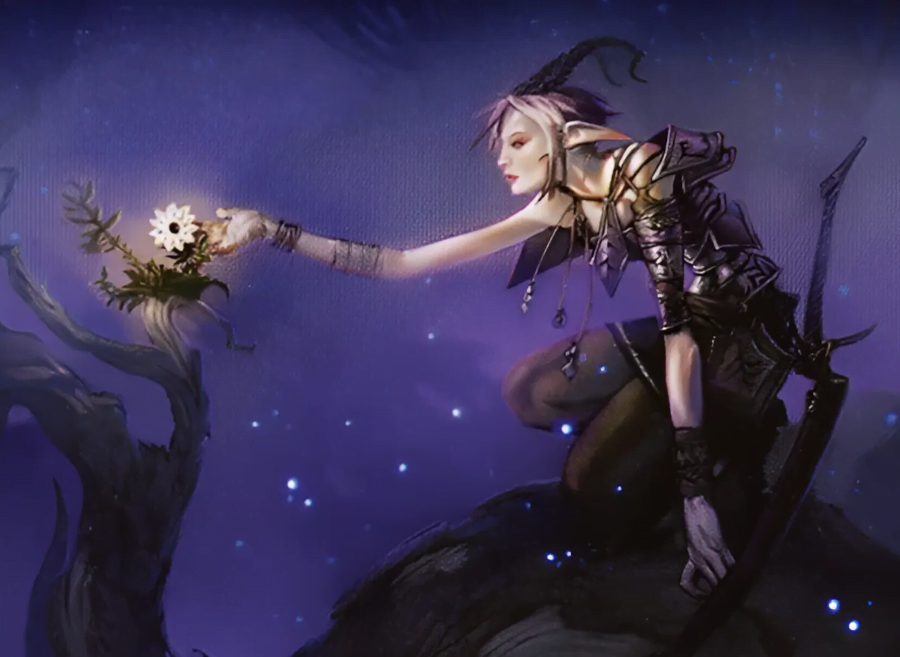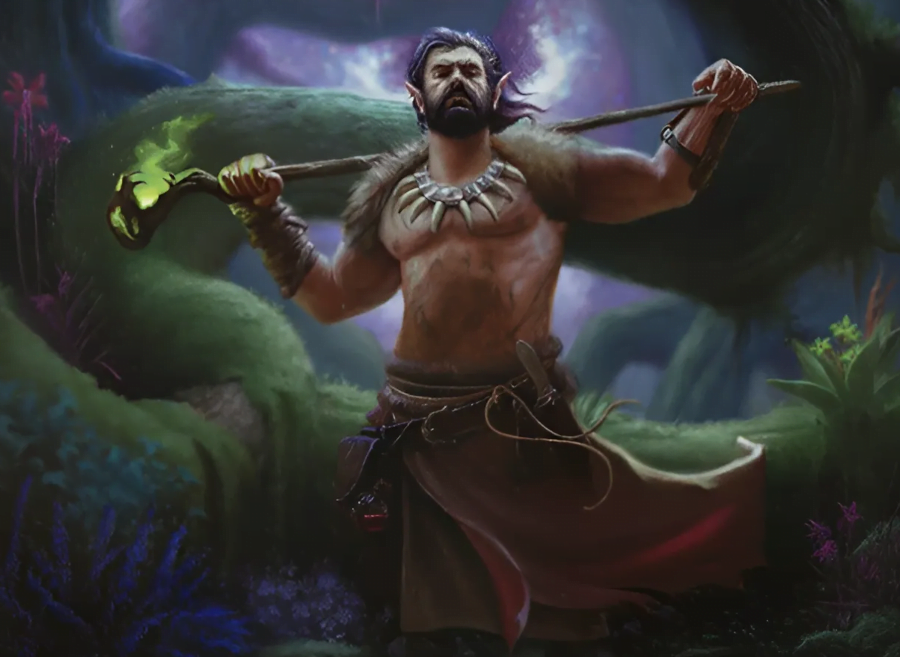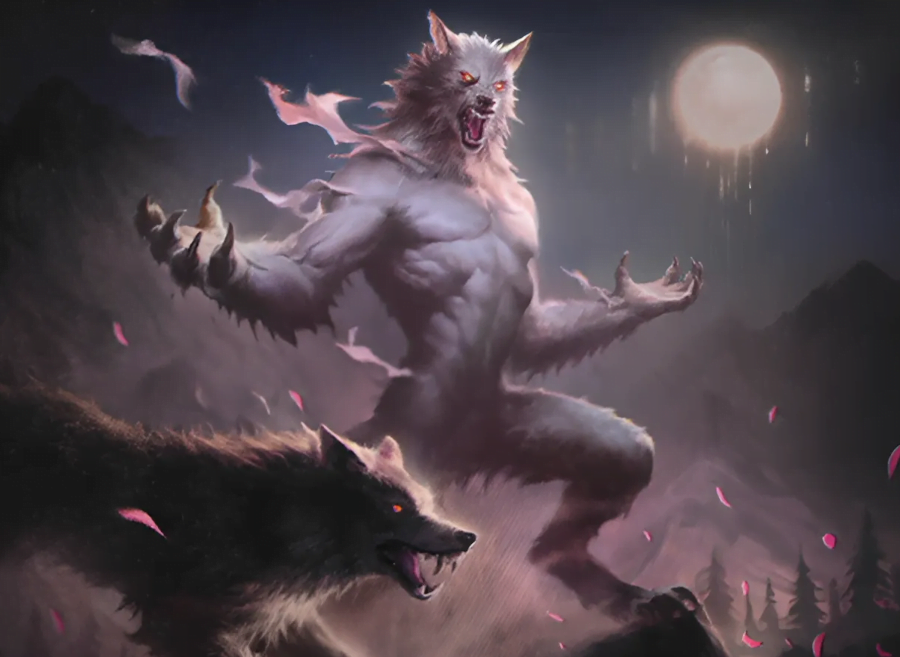Say that like ‘where is Wizard Hut?‘
I love the 4e Druid. This is a marked change from how much I liked the 3e druid, or how often you might see me playing a druid in a Baldur’s Gate game. Back in 3rd edition, the druid, despite being very powerful, never really engaged me, in part perhaps because I was always trying to find something exploitative and powerful rather than merely accepting the juggernaut of a toolkit the game just left in the Player’s Handbook. You couldn’t get clever with the Druid, you just had to pick it up and use it, like some sort of society of creative anachronisms where one of the anachronisms available to the players was has gun. Valid, but hardly sporting.
The Druid in 4th edition is different. Wildly different. Weirdly different, and different in one of those ways that shows what I think of as a seam in the design between 4th and 3rd editions of D&D.
The Druid was one of 3rd edition’s great mistakes, a full spellcasting class with healer capacity to serve as a pinch-hitter healer in a group that wanted things a little more varied, addressing an enormously complex potential build from its earlier edition, 2e, and all in the process, resulting in some deeply confused mash up of abilities that attempted to address confusion with volume. The druid of 2e had a special unique set of rules compared to the Cleric — for example, at a certain level, you passed into a specific category of Druidic ability and now you were technically a Hierophant, and Hierophants had seven extra spells of every level. Of course there was a limited supply of Hierophants in the world, so there was a question of if you could level up if another one existed, and maybe there’s a one-in, one-out policy? First in, first fired?
Anyway, I can’t speak to how it played, but I am at least aware, on the edges of it, that the 2e druid was odd. It had a lot of things it could do, but much of how it worked, reading the books, seemed to be interesting but challenging to manage. You could wild shape, you could heal, you could cast utility spells, you could even fight with some melee weapons — personally, I didn’t see any of it worth it, because none of the things it could do it could do very well.
3e addressed this seeming difficulty by instead taking all those different options and bringing them all up to the same level. Wild Shape worked by checking traits of monster units, which meant that you weren’t limited to specific reinterpretations of animals and instead could do what a druid feels like it should do — you know, turn into an animal. The spells were rebalanced and shared across different classes, which meant that they tended to work in a more standardised way. Armour rules were aggregated, and weapons were made less terrible.
The result was that the 3e druid went from being ‘decent’ at a bunch of things to ‘good’ at everything it wanted to do. The problem of the druid then became about picking the thing you wanted to at every opportunity, and doing a good job of it — you’d have druids carrying wands of healing so they could dedicate their spell slots to more important tasks, like Flame Striking opponents, or messing up the battlefield with roots. You’d also see druids keeping the ‘best’ list of animals on hand, and every new monster book presented a new chance for druids to develop a new best form.
It also created the strange question of What does the druid do?
The answer was ‘everything.’
The 4e Druid, in comparison and contrast to these designs is something very different that touches, at best, on the periphery of what the 3e Druid could be. I mean it stands to reason, you can only ever touch on doing everything when something you’re working from is so powerful. 4e with its role system of Defender, Striker, Leader and Controller, and its reliable, reusable balance math suddenly was confronted with fitting an elephant into a shoebox.
How do you represent something busted that could do everything in the context of a new system that sought to explicitly prevent that? I joked when the game was new that the four roles were Defender, Striker, Leader and Miscellaneous. That any class too powerful, with too much stuff it could potentially do, got thrown to the Controller role as suggested by the first Controller we ever saw being the Wizard. Oh and back in Player’s Handbook 1, the Wizard had a few builds that were pretty ridiculously pushed — the pinball wizard, I’ll talk about it sometime — and that meant that it was easy to feel like the Controller Does Everything.
That impression diluted through experience, of course, and eventually it came to that while yes, the Controller sure has some Miscellaneous vibes, the core of what the Controller was there to do was to attack the enemy action economy. Nice and obvious to a non giga-nerd, right? Okay, how about this: The leader lets you do more things, the controller stops them from doing more things?
And into this space, they poured the druid.
It works beautifully, for my tastes; the druid needs to do lots of things to feel properly druidy, but you need to make sure the doing lots of things doesn’t unbalance the game. Controllers have the widest variety of things they can do and ways they can do them – inflicting status conditions, changing enemy position, preventing specific action types, making areas on the battlefield inaccessible, these are all ‘controllery’ things, and that means there’s a lot of different ways you can flavour them. The Invoker is most famous for making zones in the play space hard to deal with, the Wizard has a build that slides things all over the place, and the psion controls people with immense penalties to their damage rolls.
Obligatory pause where, while reading this aloud, for either Fox or I to comment on how amazing it is that Dishearten is an AOE power.
Anyway, the druid was designed to be a mode switcher class. That is, there are two ways a druid can do things. One is a melee controller that makes a single target’s life harder, the other is a ranged controller that makes a large group of enemies’ lives harder. This mode switching then adds a new element to the class that your powers can interact with, where you now have control powers that can add a mode switching element to them as well. This is your Wild Shape – you transform into some kind of nonspecific beast, which can use your Wild Shape powers. Each form has fewer powers to manage, and you can build your druid to specialise in one or the other or do a mix.
This lets the druid do the ‘a lot’ without letting them actually do everything. You have a lot of choices and a lot of ways to play with those pieces, but even just how often you use the mode switch is part of what the druid does to control the battlefield. When I first played a druid, it was not uncommon to start a fight out of wild shape, use the first turn to make some kind of area control power, then shift into wild shape for the rest of the fight kicking people into that area control power. There are druids builds that work like wizards and only ever shapeshift to get away from problems, and make a hit while scuttling away, or to sit on a specific type of problem. There were druids who focused on summoning monsters and using them as kind of turrets on the battlefield, positioning allies in a way that benefitted them around those summons.
Lone artillery combat encounters, where you have a bunch of stuff in front of a long-ranged attacker? Druids love those. Even at level 1, that artillery is spending their days completely stuck underneath a Fire Hawk power.
Problem is, of course, that if you want to do Everything doing a Lot is going to miss something. That was what led to the subclasses of the druid, the ones that added healer elements to the druid, because the druid back in 3e could do that. It added animal companions, because the druid back in 3e could do that. Now I don’t worry too much about these things because if I wanted an animal companion on my Druid, I’d take a theme for that, but also because these changes were introduced in an Essentials book.
Which is to say, they’re crap.
They’re not crap crap, like I try to defend Essentials as giving players a choice for simplified character builds, but in the specific case of the Essentials Druids, in order to work with the simplified choices, these Essentials druids with their animal companions and their healing powers have to look at all other Druid powers and not use them. The only use they get out of their animal companion is using the specific subset of powers that make them work, and that makes combat more samey. But again: That’s a thing you probably want if you want a simplified build.
Still, it gives rise to my favourite joke – I mean like, funny thing, not really a joke, there’s no subversion of reality or anything here – about the Healer Druid. See, every Leader in the game gets an encounter power, usable twice a combat at level 1, that heals an ally with a bonus. Every class gets their own version that lets them distinguish their class specifically and add some interesting detail that shows how this Leader differs from other Leaders.
The Healer druid build gets Healing Word.
The Cleric power.
Literally, the same power, same name, listed as a Cleric power.



1 Comment
@updates "You couldn’t get clever with the Druid, you just had to pick it up and use it, like some sort of society of creative anachronisms where one of the anachronisms available to the players was has gun. Valid, but hardly sporting."
This accurately sums up why to this day I've still not played a Druid in 3.0/3.5/PF – besides largely avoiding full casters as one of the resident optimisers in mixed parties, Druid in 3.5 was especially egregious in how even intentionally playing suboptiomally still…well, as you say, wasn't *sporting*
Like if I play a Wizard with intentionally flavour and poorly optimised choices instead of tapping into the 1001 ways they snap reality like a twig, then I'm still a squishy mage in a bath robe.
But a "bad" Druid who neglects all the battlefield control spells is still a somewhat competent combatant and has a companion that, depending on the level range, is between 60% and 95% of a whole other Fighter in the party
Then the 4e Druid manages to capture that mishmash feel of abilities in a way that has them shifting betwene roles in real-time mid combat rather than specialising and just still being good at the others – and also handled Wild Shape far more elegantly, by largely letting the flavour be up to the players and it being an enabler for different powers rather than needing to balance countless statblocks for player use
(As with many things 5e did, going back to stat blocks for Wild Shape was a mistake, but not even the biggest mistake they made with Wild Shape, where basically the subclass that specialised in Wild Shape was the only one that could use it effectively in combat and used it as effectively extra HP, where all other Druids largely used it for out-of-combat scouting instead, in my experience)
(Pathfinder took the route of adapting Polymorph spells into just providing small stat boosts and certain specific abilities and then making Wild Shape do that – a more balanced approach, but weird in that you still needed to go stat block diving through Monster Manuals to find a creature that had all the darkvision, flight, natural attacks you wanted just like 3.5…but then didn't actually use its stats and referred to a spell. And overall Druids were still too good at everything, even with weaker spell lists and wild shape in PF)
My main comment on the Healing Word joke with the Sentinel is that IIRC, that's not even the full joke as giving a completely unaltered Healing Word to Sentinel actually broke the power with errata for a while.
Because Healing Word per PHB had the Divine keyword, but I the Sentinel version had the Primal keyword at first (or no keywords besides Healing, I forget which), and by some RAW arguments meant it was a reprinting of Healing Word rather than an entirely new power with the same name (as all the other statistics were the same), which led to Cleric's losing the Divine keyword on the power and thus a lot of feats and the Healing Lore class feature stopped working with Healing Word
I think by later releases if they'd given it the Primal keyword they later removed it, as I recall the Online Compendium and Character Builder both had it as a Healing keyword only power for both classes by the time they stopped doing updates for 4e, which means the offline tools have the same thing* – instead of more sensibly making Healing Word (Divine) and Healing Word (Primal) as 2 seperate powers with the appropriate keywords (like how Inspiring Word, Majestic Word, etc have Martial and Arcane respectively)
(* strictly speaking, the offline character builder actually has the 2 healing words coded as 2 different powers internally for technical reasons, but still lacks the Divine/Primal keywords in order to follow the last official errata on the power)
I mean, every DM I've played with has basically ruled the Cleric version has Divine keyword and Sentinel version has Primal keyword so the Cleric's feat, class feature and item support actually works, rather than following strict RAW
(I'd say adding Primal keyword to enable Sentinel Healing Word support, but my understanding is no such support exists and Sentinels actually have to Multiclass Cleric for their Healing Word to actually have any support at all)
The main thing Sentinel actually brought to the table was some nice support utilities for Druids and Protector Druids to poach (like Clear the Chaff), a weird (and hottly-contested as to how it actually functions) Hybrid choice if you really wanted an Animal Companion but couldn't take Fey Beast Tamer for whatever reason
(and even then was still kinda bad unless your table ruled that Hybrid Sentinels could take any Druid powers instead of being locked into Essentials choices – if they did, then Hybrid Sentinel was way too good, if they didn't, it was kinda bland and awful)